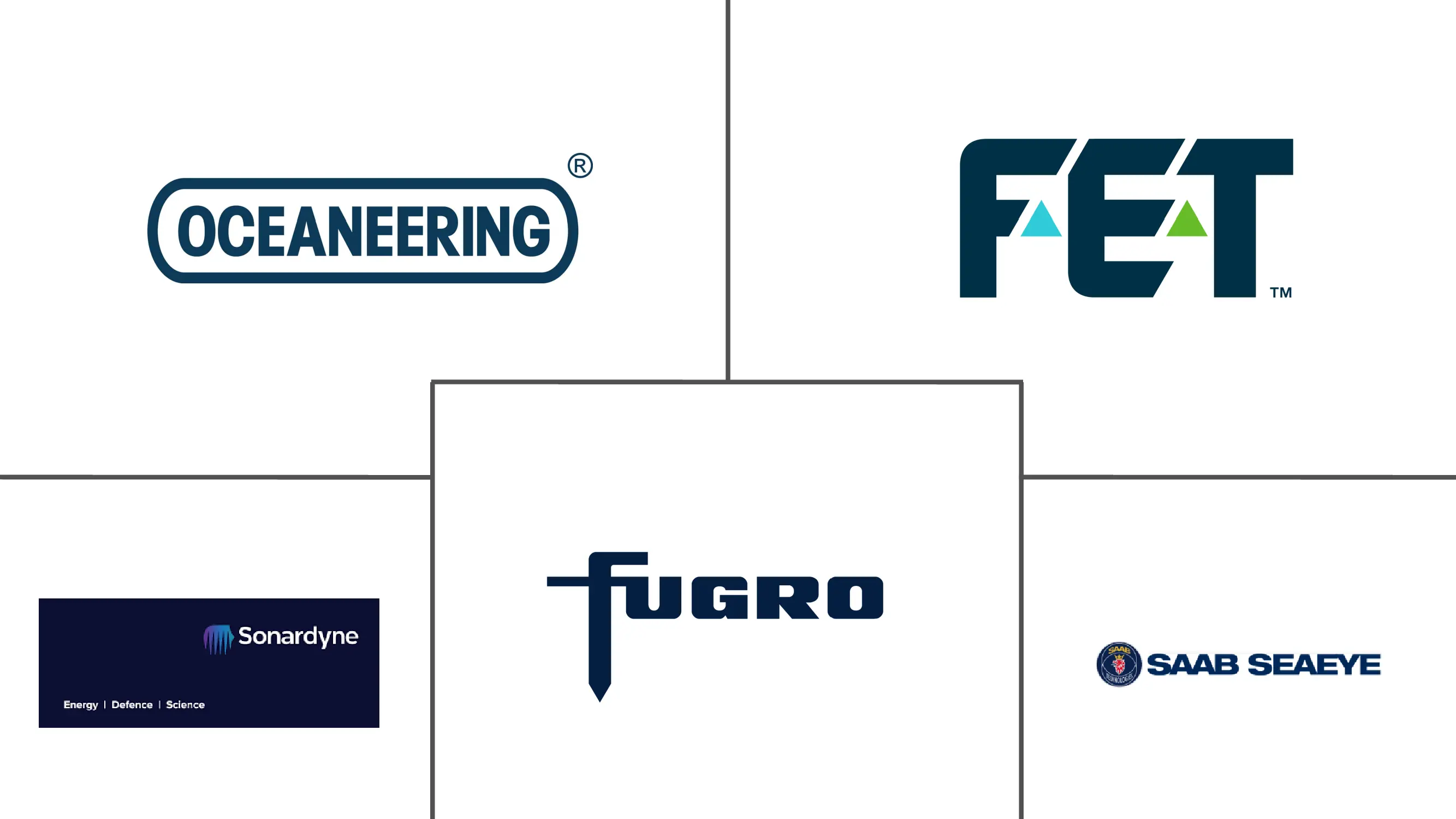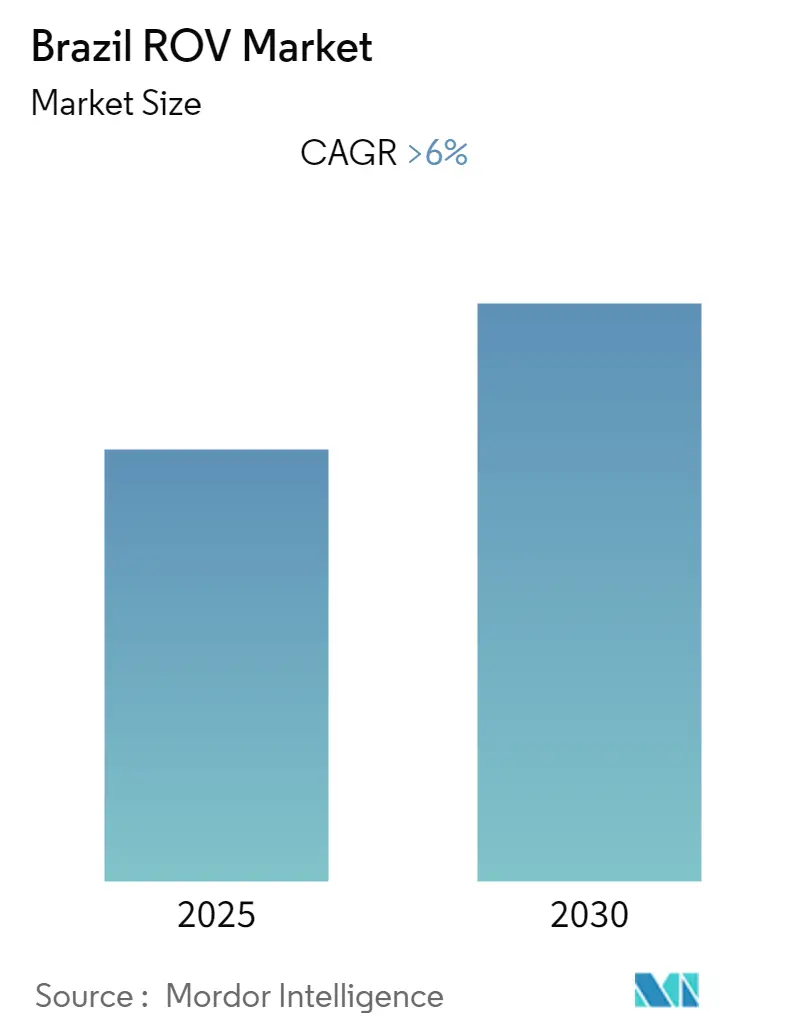
Brazil ROV Market Analysis by Mordor Intelligence
The Brazil ROV Market is expected to register a CAGR of greater than 6% during the forecast period.
Over the medium term, the ongoing deepwater and ultra-deepwater oil and gas discoveries and investments in the projects are expected to drive the Brazilian ROV market over the forecast period. On the other hand, there is a high initial cost associated with ROV units, which also increases their operation and training costs. These factors hinder the sale of new ROV units, restricting the growth of the Brazilian ROV market.
Nevertheless, the ongoing deepwater and ultra-deepwater oil and gas discoveries and shale gas explorations are expected to create huge opportunities for ROV deployment over the forecast period.
Brazil ROV Market Trends and Insights
Oil and Gas Application to Dominate the Market
Oil and gas fields exist under inland water bodies as well as offshore. Exploration, drilling, and development of these resource fields from underwater locations are crucial to supplying the world's ever-growing energy needs.
Remotely Operated Vehicles (ROVs) are useful in the oil and gas industry. The robots are underwater machines that assist with various activities that are related to subsea exploration and development. Due to the rise in the installation of underwater infrastructure for oil and gas field development, ROVs have become almost indispensable in the oil and gas industry. There have been a number of new oil and gas discoveries in Brazil, both shallow and deepwater, which has resulted in an increase in the demand for ROVs.
In July 2022, Equinor Brazil awarded Valaris, represented by Ensco UK Drilling Limited and Ensco do Brasil Petróleo e Gás LTDA, a 540-day drilling contract scheduled to start in 2023 on behalf of the Bacalhau license partners. Valaris DS-17 drillship has been contracted to drill appraisal wells, plug old exploration wells, and conduct additional drilling in Brazil. The contract includes drilling services as well as additional services, such as remotely operated vehicles (ROV), managed pressure drilling (MPD), casing running, slop treatment, and cuttings handling.
In May 2022, Total Energies announced the start of production from the first phase of the giant Mero field in the Libra block, 500 kilometers from Rio de Janeiro, in the prolific pre-salt region of the Santos Basin. This first phase is going to be followed by three additional development phases, with the Mero-2, Mero-3, and Mero-4 floating production, storage, and offloading units (FPSOs), each with a production capacity of 180,000 barrels per day and production start-ups scheduled between 2023 and 2025.
In May 2022, Shell and Petrobras contracted Saipem to use its FlatFish subsea drone for two pilot projects involving the inspection campaigns of two ultra-deepwater fields offshore Brazil operated by the two energy companies. According to BP Statistical Review of World Energy, in 2021, Brazil produced 2.987 million barrels per day of oil, an increase of 19.3% from 2015.
Hence, increasing investments and the use of ROVs in deepwater activities are factors driving the Brazilian ROV market.
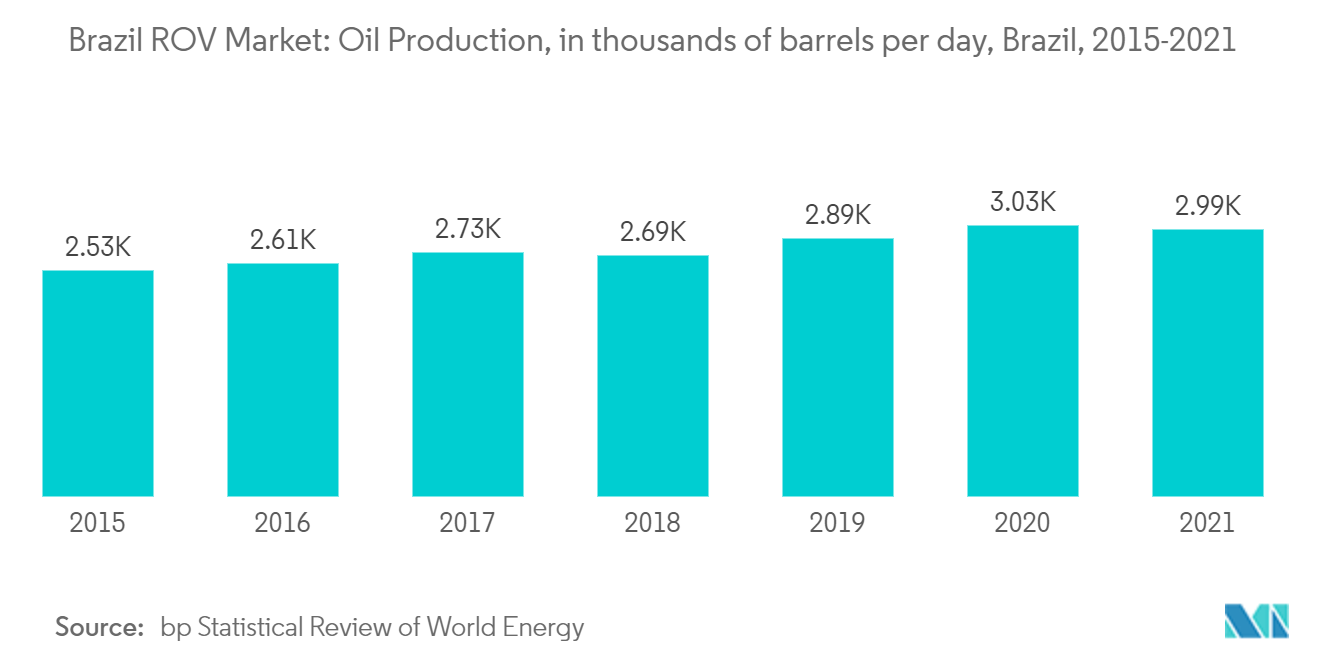
A Rise In Deepwater Offshore Development Activities to Drive The Market
As oil companies in South America continue to utilize FPSOs to develop their hydrocarbon resources, Brazil is expected to easily maintain its position as the top country of floating production, storage, and offloading vessels for years to come. Petrobras already has a large number of FPSOs along the southeastern coast of Brazil, and many more will be built over the next few years. The company plans to put 84% of its investments toward oil and gas exploration and production, focusing on assets in deep and ultradeep waters. It announced plans to invest USD 68 billion from 2022 to 2026 to boost oil production in the subsea pre-salt area. A total of 2.7 million barrels of oil equivalent are expected to be produced by Petrobras in 2022, including natural gas and oil.
In July 2022, Equinor and TechnipFMC signed a letter of intent for the integrated front-end engineering and design studies for the BM-C-33 pre-salt project offshore Brazil, which could be worth over USD 1 billion. More than 1 billion barrels of oil equivalent in recoverable resources are estimated to be present in the BM-C-33 development in the Campos basin, which includes the Pao de Acucar, Gavea, and Seat discoveries. A floating production, storage, and offloading vessel with a capacity of 125,800 barrels of oil and 16 million cubic meters of natural gas are going to be used in 2026 to begin operations.
In June 2022, Tenaris was awarded a four-year contract by Petrobras to supply a comprehensive package of products and services for Petrobras' flagship Buzios deepwater project. This Buzios field is among the world's largest deepwater oil and gas fields, with production expected to reach 2 million barrels per day by 2030, up from its current production of 0.7 million barrels per day, which equals approximately 70% of Brazil's total output today. According to Associacao Brasileira de Private Equity & Venture Capital, Brazil has 763 offshore oil and gas rigs, an increase of 52.9% from 2020.
Therefore, based on the factors mentioned above, the oil and gas application segment is expected to dominate the Brazilian ROV market during the forecast period.
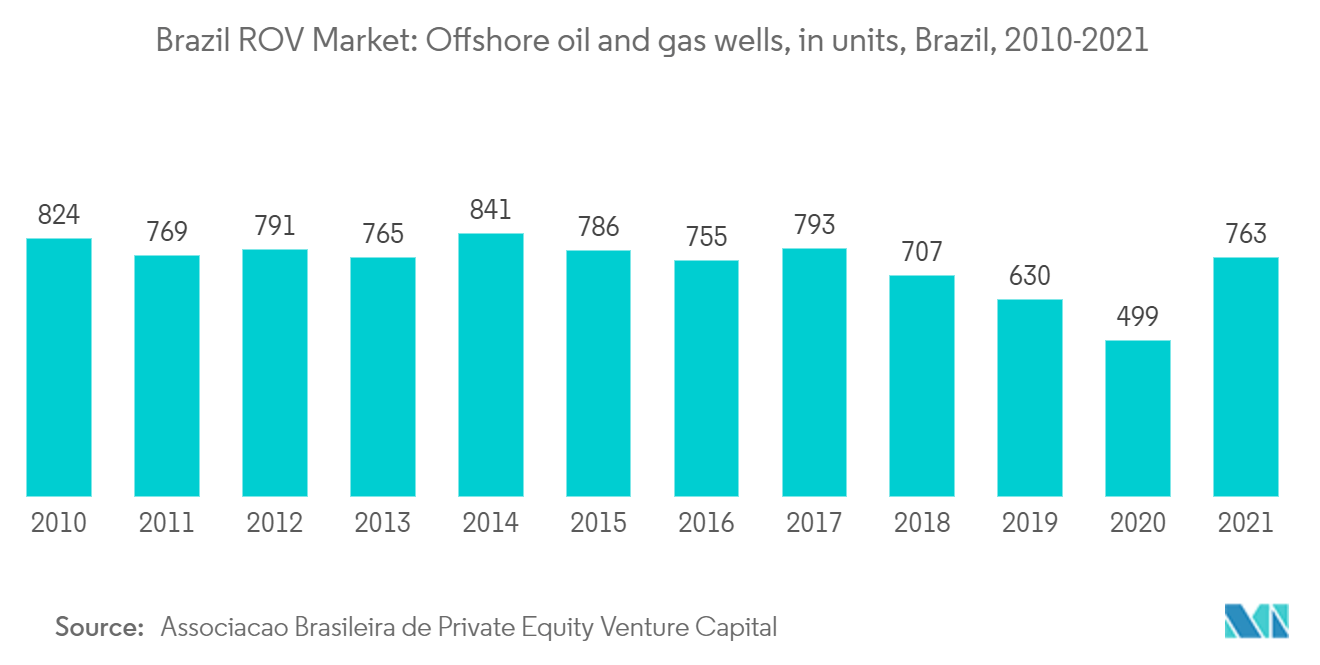
Competitive Landscape
The Brazilian ROV market is moderately fragmented. Some of the major players (in no particular order) are Oceaneering International Inc., Forum Energy Technologies Inc., Sonardyne International, Fugro, and Saab Seaeye Ltd.
Brazil ROV Industry Leaders
Oceaneering International, Inc.
Forum Energy Technologies, Inc.
Sonardyne International
Fugro
Saab Seaeye Ltd
- *Disclaimer: Major Players sorted in no particular order
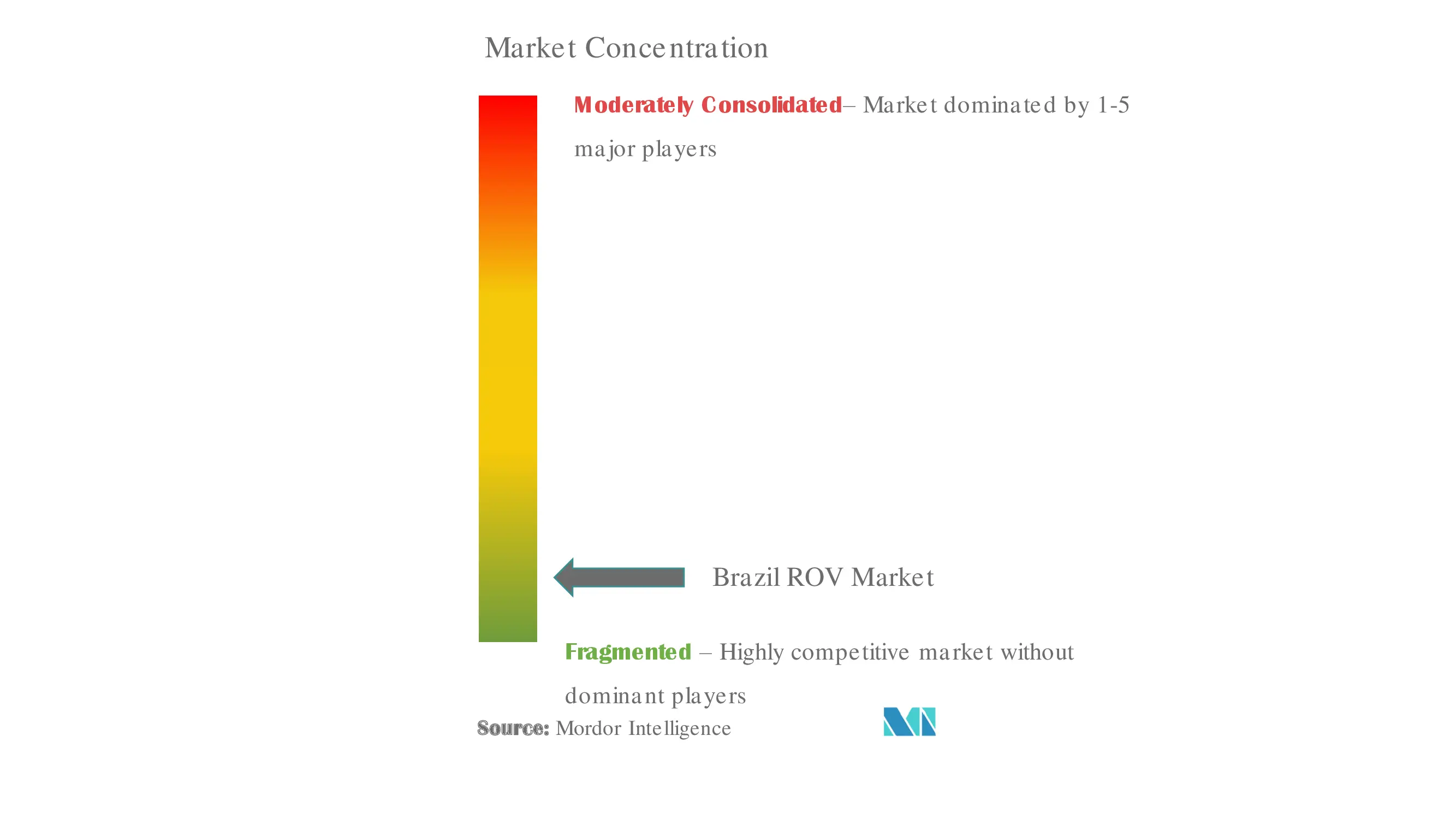
Recent Industry Developments
- July 2022: The Subsea Robotics segment of Oceaneering International has been awarded a multi-year service contract supporting Petrobras projects off the coast of Brazil. AKOFS Offshore's subsea equipment support vessel (SESV), Aker Wayfarer, will use Oceaneering's survey and ROV services. A Millennium Plus work class ROV, specialized tooling packages for each ROV, ROV personnel for simultaneous operations, and survey equipment and personnel are included in the scope of work. The contract is for four years with an option to extend.
- June 2022: The Forum Energy Technologies (FET) delivered two work-class remotely operated vehicles (ROV) to the Brazilian marine engineering company Oc to support its deepwater intervention operations and enhance its energy offering. FET's UK facility, Kirkbymoorside, North Yorkshire, produced the systems delivered in the first half of 2022. Adding new capabilities to Oceanica's fleet, FET provided two Perry XLX-C ROVs designed specifically to handle challenging subsea conditions.
Brazil ROV Market Report Scope
"ROV" refers to a remotely operated vehicle. These vehicles are highly maneuverable, unmanned underwater vehicles capable of exploring ocean depths while operated from the surface of the water. ROVs, or remotely operated vehicles, allow exploring the ocean without actually being there. These underwater machines are controlled by a person, typically on a surface vessel, using a joystick in a similar manner to playing a video game. The ROV is connected to the ship by a network of cables, or tethers, which transfer electrical signals between the operator and the vehicle. An ROV was originally developed for industrial applications, including inspections of underwater pipelines and structural testing of offshore platforms. Nowadays, ROVs are used in many different applications, many of which are scientific. They have proven extremely valuable in ocean exploration and are also used to facilitate educational programs at aquariums and connect with scientific expeditions live over the Internet.
The Brazilian ROV market is segmented by application into oil and gas, defense, and other applications. For each segment, the market sizing and forecasts are provided in terms of value in USD billion.
| Oil and Gas |
| Defense |
| Other Applications |
| Application | Oil and Gas |
| Defense | |
| Other Applications |
Key Questions Answered in the Report
What is the current Brazil ROV Market size?
The Brazil ROV Market is projected to register a CAGR of greater than 6% during the forecast period (2025-2030)
Who are the key players in Brazil ROV Market?
Oceaneering International, Inc., Forum Energy Technologies, Inc., Sonardyne International, Fugro and Saab Seaeye Ltd are the major companies operating in the Brazil ROV Market.
What years does this Brazil ROV Market cover?
The report covers the Brazil ROV Market historical market size for years: 2020, 2021, 2022, 2023 and 2024. The report also forecasts the Brazil ROV Market size for years: 2025, 2026, 2027, 2028, 2029 and 2030.
Page last updated on:
Brazil ROV Market Report
Statistics for the 2025 Brazil ROV market share, size and revenue growth rate, created by Mordor Intelligence™ Industry Reports. Brazil ROV analysis includes a market forecast outlook for 2025 to 2030 and historical overview. Get a sample of this industry analysis as a free report PDF download.
